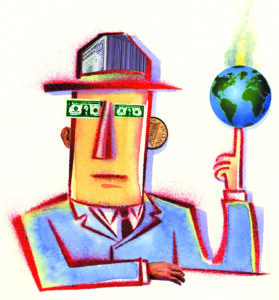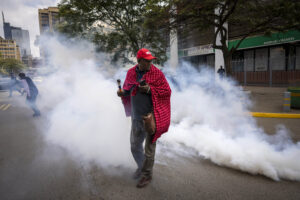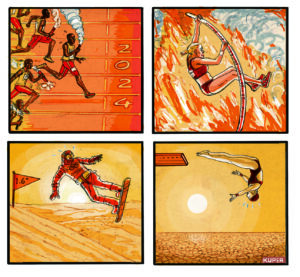Melting Away
The idea of photography as historic document is particularly poignant in a new book chronicling endangered polar regions, with magnificent portraits of icebergs and altered landscapes that are at risk of being lost forever. Princeton Architectural Press
Princeton Architectural Press
Princeton Architectural Press
“Melting Away: A Ten-Year Journey Through Our Endangered Polar Regions” A book by Camille Seaman
In 1999, photographer Camille Seaman’s flight to Los Angeles was overbooked. Little did she know that giving up her seat then in exchange for a free round-trip ticket would change her life.
In between menial jobs, she was at a crossroads moment. Taking a cue from the airline’s name, Alaska, a place she never dreamed of visiting, the native New Yorker soon set off on a solo adventure to Kotzebue, Alaska. Its proximity to the Bering Strait, where her Native American ancestors migrated to the new world about 15,000 years ago, was the main factor in her choice of destination. Unprepared and ill-supplied, she attempted to walk across the frozen sea toward Russia. It was here, in a minus 50 degree snowstorm, hearing only her Darth Vader-like breathing, that she had an epiphany — an extraterrestrial moment as she describes it, setting in motion a decade-long journey documenting fragile polar regions.
Seventy-five photographs culled from her arctic journeys are compiled in a new book, “Melting Away: A Ten-Year Journey Through Our Endangered Polar Regions.”
From 2003 to 2011, Seaman, a TED senior fellow, spent several months a year exploring the Arctic, Antarctica and the Norwegian archipelago Svalbard. While sailing on expeditionary vessels, modern cruises, rickety old ships and Russian icebreakers, she mingled with climatologists, scientists, tourists, zoologists and geologists, all informing her art.
“Melting Away” is a trove of awe-inspiring, magnificent panoramas and indelible portraits of icebergs, penguins, polar bears and altered landscapes. Her personal journey, recounted in six essays, provides an equally compelling story.
Each page is a window to an extraordinary world of ice and snow. Seaman masterfully captures the exterior beauty of the region while examining the perilous conditions just beneath the surface. The photographs elicit an immediate, visceral reaction of both exhilaration and serenity.
A glorious vista of the Rasmussen Glacier in Greenland taken in 2006 encompasses detailed layers of earth, sea and air with breathtaking clarity. A gentle wake trails a raft of explorers, the clear water reflecting an ice-blue, smoky gray coastline, with a low spattering of clouds amid snow-capped peaks.
Seaman never considered photography as a profession in her youth. As a visual arts student at LaGuardia High School of Music & Art and Performing Arts (also known as the “Fame” school) she was handed a Nikkormat camera, taught the basics, then told to “go out and photograph your own experience.” While attending SUNY Purchase, she studied photography and drawing under the tutelage of filmmaker and musician John Cohen. After college she moved to Northern California’s Bay Area, where she bounced around in various part-time jobs, surfed and made a decent living doing beadwork.
With Seaman for a surname, she seemed destined to work around water. Her connection to nature is deeply rooted in her Native American heritage. The daughter of an African-American/Italian mother and Shinnecock father, Seaman grew up “playing with the earth” in Long Island, N.Y., on an 800-acre reservation. Taught by her grandfather, she learned to fish, garden, listen to the trees and “quiet your mind.”
Everything her grandfather taught Seaman manifested on that first fateful night in Alaska. It was during the long trek back to her hotel, unable to distinguish the sky from the ground, that she understood that she was a “creature of this planet … everything interconnected through a life source.” Upon her safe return, she discovered she was a few weeks pregnant with her daughter.
It wasn’t until 2001, after 9/11, that she considered herself a professional photographer. The realization that her daughter would never know the twin towers in the same way she did hit home.
“I understood for the first time the importance of a photograph as a historic document … as a memory that might be shared with others,” she writes, referring to the destruction of the World Trade Center.
Embracing her new vocation with unwavering intent and purpose, she studied with Sebastiao Salgado and Paul Fusco, and was taken under the wing of National Geographic photographer Steve McCurry during a trek through Tibet. He taught her the invaluable skill of utilizing natural light.
Skies in the North and South Poles span the spectrum from ominous to heavenly, even hallucinatory. At the mercy of the weather gods, Seaman skillfully works wonders with the fluctuating shades of light mixed with the natural aesthetics of the icy environments.
An overcast day on Kongsfjord Glacier in Svalbard exposes brilliant turquoise blues in an iceberg cluster resembling an Azurite mineral. Golden clouds lit by the sun’s rays create a magical scene in the Antarctic Peninsula.
In 2010 Seaman had the fortune to experience a sunset and sunrise simultaneously in the Antarctic Sound, capturing the resulting splendor of a roseate and auburn imbued sky.Seaman, whose work has appeared in National Geographic, The New York Times and Time, approaches her subjects as a portraitist. The unique personalities of ice formations reveal themselves through distinct design, scope, color, sound and movement.
Classifications vary from majestic Pinnacle icebergs to house-sized Bergy Bits, usually found in clusters in late stages of melting, and growlers, small chunks of floating ice that eek out an animalistic sound as trapped air escapes.
Ice shelves, thick floating expanses of ice and snow, resemble flat top desert mesas. As a piece calves, or breaks off from a glacier or ice shelf, it is reborn as an iceberg or pinnacles. These angular monuments appear to be carved from the marble of a great Grecian temple. Adrift and alone, they are stately and haunting in their solitude.
Gazing upon the sheer mass of the stranded icebergs, I felt small, meek and exposed.
Seaman’s series of local wildlife, particularly penguins and walruses, is beguiling and often comedic. She compares photographing a herd of walruses to photographing potatoes.
An abandoned dog sled harks back to the heroic age of great explorers when Roald Amundsen and Ernest Shackleton boldly went where no man had gone before. Red and green oil drums scattered in the snow, remnants of whaling, former military bases and coal mining settlements, serve as a reminder of man’s propensity to claim the rich resources of a newfound territory.
Images of polar bears and accompanying text redirect attention to the consequences of rising sea levels. Seaman witnessed an entire generation of birds wiped out as a famished young bear in Svalbard climbed a 30-foot ridge to their nests and gobbled up every single recently laid egg. These actions set off a chain of events: “No ice, no seals, hungry bear eats birds, no birds to eat pests on European farms and so on,” she explains.
This desperate scene, along with the widespread lack of ice and snow in 2011, was the last straw. Seaman hasn’t returned since.
Despite over 190 nations coming together in Peru in December for a U.N. Climate Change Conference to discuss limits on greenhouse gases, there are still people who deny the reality of climate change. Seaman prefers a subdued approach in addressing the issue. Her mantra, “be a good ancestor,” while commendable, is a tad nebulous for the layman unfamiliar with the science and causation of global warming.
The first time Seaman saw an iceberg, she felt dizzy and her heart began to race. She hopes by the simple act of looking at her pictures we will feel what she felt and start a dialogue.
Your support matters…Independent journalism is under threat and overshadowed by heavily funded mainstream media.
You can help level the playing field. Become a member.
Your tax-deductible contribution keeps us digging beneath the headlines to give you thought-provoking, investigative reporting and analysis that unearths what's really happening- without compromise.
Give today to support our courageous, independent journalists.






You need to be a supporter to comment.
There are currently no responses to this article.
Be the first to respond.